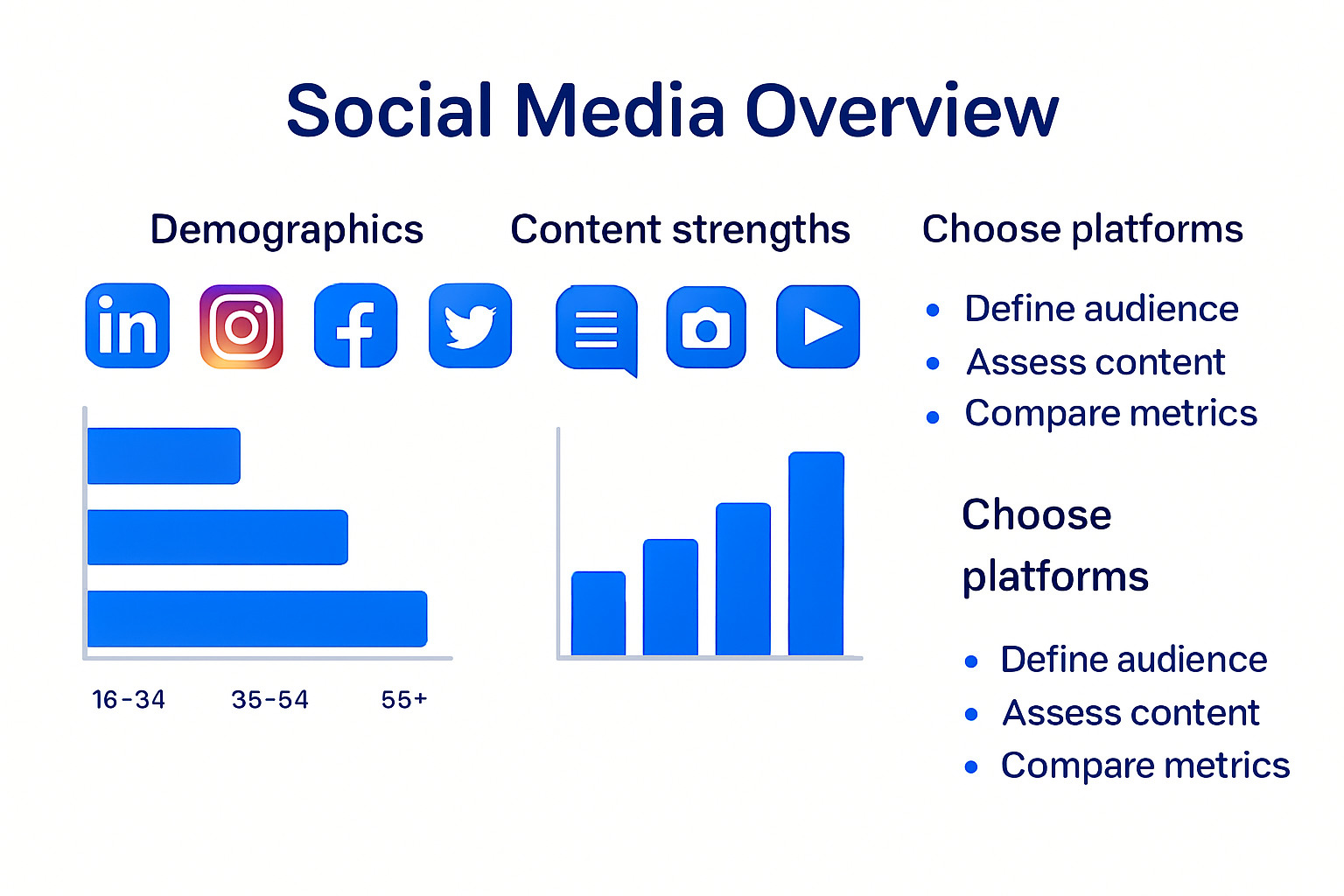Social media is shaping the way every business grows online. In 2025, more than 4.9 billion people worldwide are expected to use social platforms daily, making it the biggest audience in history. Yet, chasing every channel can burn through time and budgets fast. The real opportunity is not about being everywhere but picking just two or three platforms where your ideal customers actually spend their time.
Table of Contents
- Choosing The Right Social Media Platforms
- Building Your Brand Presence Online
- Creating Engaging Content That Converts
- Measuring Results And Refining Strategies
Quick Summary
| Takeaway | Explanation |
|---|---|
| Choose 2-3 platforms wisely | Focus on social media where your audience is most active for better engagement. |
| Craft a consistent brand identity | Ensure visual and messaging consistency across all platforms to build a strong online presence. |
| Create audience-focused content | Understand your audience deeply to tailor content that resonates with their needs and preferences. |
| Use SMART goals for metrics | Establish specific, measurable, achievable, relevant, and time-bound goals for tracking social media performance. |
| Regularly adapt strategies based on analytics | Continuously review performance metrics and adjust content strategies to enhance overall effectiveness. |
Choosing the Right Social Media Platforms
Selecting the most effective social media platforms for your business requires strategic thinking and careful analysis. Not all platforms deliver identical results, and understanding the unique characteristics of each network can significantly impact your digital marketing success.
Understanding Platform Demographics and Audience Alignment
Every social media platform attracts a different demographic, making platform selection critical for reaching your target audience. Research from the Rhode Island Small Business Development Center highlights the importance of matching platform demographics with business objectives.
Consider the age ranges and professional interests of your ideal customers. LinkedIn works brilliantly for B2B communication and professional networking, attracting primarily working professionals aged 25-54. Instagram skews younger, with a strong visual appeal perfect for businesses in creative industries, fashion, or lifestyle sectors. Facebook offers broader demographic reach, suitable for businesses targeting diverse age groups.
To help you compare the main features and audiences of key social platforms, see the table below.
| Platform | Audience/Use Case | Age Range | Key Strengths |
|---|---|---|---|
| B2B, Professionals | 25-54 | Networking, thought leadership, recruiting | |
| Visual, Lifestyle | 18-34 | Visual appeal, creative storytelling, trends | |
| Broad, General | 18-65+ | Wide reach, community groups, ads | |
| Real-time Updates | 18-49 | Timely news, customer service, hashtags | |
| TikTok | Youth, Creatives | 16-29 | Viral short videos, music, challenges |
| Visual, Shopping | 18-49 (mostly women) | Inspiration, discovery, product ideas | |
| YouTube | Wide, Learning | 18-55+ | Long-form video, tutorials, education |
Content Strategy and Platform Capabilities
Your content strategy must align with each platform’s strengths. Visual brands thrive on image-based platforms like Pinterest and Instagram, while professional service providers might find more value in LinkedIn’s knowledge-sharing environment. Social Media Examiner’s annual report suggests that video content continues to dominate across platforms, with short-form videos gaining significant traction.
Business owners should evaluate platform features comprehensively. Twitter works well for real-time updates and customer service interactions. TikTok offers extraordinary reach for brands targeting younger audiences through creative, engaging short videos. YouTube remains unparalleled for long-form educational content and tutorials.
Strategic Platform Selection Principles

Not every platform requires your immediate attention. Start by selecting 2-3 platforms where your target audience is most active. Quality trumps quantity in social media marketing. Focus on creating consistent, high-quality content rather than spreading resources thinly across multiple networks.
Analyze engagement metrics regularly. Track follower growth, interaction rates, and conversion potential. Some platforms might generate more meaningful connections for your specific business model than others. A local restaurant might find Instagram more beneficial than LinkedIn, while a consulting firm could see better results through professional networking platforms.
Remember that social media platform effectiveness evolves rapidly. Stay informed about emerging trends, platform updates, and shifting user behaviors. Regularly reassess your social media strategy to ensure continued alignment with your business goals and target audience preferences.
Building Your Brand Presence Online
Building a compelling brand presence online requires strategic thinking, consistent effort, and a deep understanding of digital communication dynamics. Your online brand represents more than just a logo or visual aesthetic—it encompasses your business personality, values, and unique value proposition across digital platforms.
Crafting a Cohesive Digital Identity
Research from the University of Oxford emphasizes the critical importance of identifying target audiences and defining clear messages when establishing an online brand. Consistency becomes your most powerful tool. Ensure your visual elements, tone of voice, and messaging remain uniform across all digital channels.
Your brand narrative should communicate what makes your business unique. This means developing a clear brand story that resonates with your target audience. Authenticity drives connection. Share behind-the-scenes content, highlight your team’s expertise, and demonstrate your company’s core values through strategic storytelling.
Community Engagement and Interactive Strategies
The University of Missouri Extension recommends incorporating specific strategies to build a strong online community. Hashtags serve as powerful connectors, allowing your content to reach broader audiences interested in specific topics. Engage proactively with similar accounts, respond to comments promptly, and create interactive content that encourages audience participation.
Consider offering exclusive online incentives that motivate followers to interact with your brand. These could include limited-time offers, insider information, or interactive challenges that generate excitement and foster a sense of community. Remember that engagement is a two-way conversation—listen to your audience and adapt your strategies based on their feedback.
Measuring Brand Experience and Impact
A study in the Journal of Retailing and Consumer Services reveals that comprehensive brand experiences significantly enhance consumer motivation to engage with brand pages. This means your online presence should transcend mere promotional content and create meaningful interactions across sensory, emotional, intellectual, and behavioral dimensions.
To clarify the aspects of brand experience you should focus on, review the table below.
| Brand Experience Aspect | Description | Example Approach |
|---|---|---|
| Sensory | Engaging with audience through visuals & audio | Eye-catching graphics, branded videos |
| Emotional | Creating feelings or emotional responses | Telling authentic stories |
| Intellectual | Stimulating thought and problem-solving | Educational posts, insights |
| Behavioural | Encouraging actions and participation | Polls, challenges, comment prompts |
Track key performance indicators that demonstrate your brand’s online impact. These might include engagement rates, follower growth, website traffic from social platforms, and qualitative feedback. Use analytics tools to understand which content resonates most with your audience and refine your approach accordingly.
Developing a robust online brand presence is an ongoing process of learning, adapting, and connecting. Stay curious, remain flexible, and continuously experiment with new approaches to maintain a dynamic and engaging digital identity. Your online brand is not just about visibility—it’s about creating genuine connections that transform casual followers into loyal advocates.
Creating Engaging Content That Converts
Transforming social media followers into customers requires a strategic approach to content creation that goes beyond simple posts and updates. Effective content speaks directly to your audience’s needs, challenges, and aspirations.
Understanding Your Audience Deeply
Research from the Journal of Hospital Medicine emphasizes the critical importance of understanding your target audience. Successful content creation starts with comprehensive audience research. Develop detailed audience personas that capture demographic information, professional challenges, personal interests, and communication preferences.
Analyze your existing audience interactions. What content generates the most comments? Which posts receive the highest engagement? These insights provide a roadmap for creating more resonant content. Pay attention to the language your audience uses, their pain points, and the solutions they seek.
Crafting Compelling and Concise Messages
A controlled experiment on social media communication discovered that message brevity significantly impacts content success. Aim to communicate your core message within 10-20% fewer words. Clarity trumps complexity. Your content should be immediately understandable, removing unnecessary jargon and complicated explanations.
Structure your content to capture attention quickly. Use powerful opening lines that address a specific problem or challenge. Visual elements like infographics, short videos, and eye-catching images can dramatically increase engagement. Break longer content into digestible chunks with clear headings and subheadings.
Strategic Content Optimization Techniques
The University of California, Davis recommends strategic hashtag usage to enhance content visibility. Select 3-5 relevant hashtags that precisely match your content’s subject matter. Avoid generic or overly broad hashtags that get lost in massive streams of content.
Develop a content mix that provides value across different formats. This might include educational tutorials, behind-the-scenes glimpses, customer success stories, and interactive polls. Create content that solves problems, answers questions, or provides unique insights your audience cannot easily find elsewhere.
Remember that conversion is about building trust. Your content should consistently demonstrate your expertise, reliability, and understanding of your audience’s unique challenges. Focus on creating genuine value rather than aggressive sales tactics. When you consistently provide helpful, insightful content, followers naturally become more interested in your products or services.
Track your content performance meticulously. Use analytics to understand which types of content generate the most engagement, lead to website visits, and ultimately drive conversions. Be prepared to adapt your strategy based on these insights, continuously refining your approach to meet your audience’s evolving needs.
Measuring Results and Refining Strategies
Effective social media marketing requires more than creating content—it demands systematic measurement and continuous strategic refinement. Without robust analytical approaches, businesses risk investing resources into ineffective digital strategies.
Establishing Meaningful Performance Metrics
The University of Florida’s Institute of Food and Agricultural Sciences emphasizes the importance of setting SMART goals for social media performance tracking. Specific objectives transform vague intentions into actionable strategies. Instead of general aims like “increase followers,” define precise targets such as “grow Instagram followers by 15% within three months” or “increase engagement rate from 2% to 4% by quarter’s end”.
Key performance indicators (KPIs) should align directly with your business objectives. These might include reach, engagement rate, click-through rates, conversion rates, and return on investment. Different platforms offer distinct analytical tools, so familiarize yourself with each platform’s native analytics capabilities.
Comprehensive Performance Analysis
The Barcelona Principles 3.0 recommend a holistic approach to performance evaluation that encompasses both quantitative and qualitative measurements. Quantitative metrics provide numerical insights—follower count, likes, shares, and website traffic. Qualitative analysis captures sentiment, brand perception, and audience interaction quality.
Utilize advanced analytics tools that offer deeper insights beyond surface-level statistics. Look for patterns in audience behavior, content performance, and seasonal trends. Track which content types generate the most meaningful interactions. Are tutorial videos generating more genuine engagement than product announcements? Do infographics perform better than text-based posts?
Strategic Adaptation and Continuous Improvement
Measurement is only valuable when it drives actionable change. Develop a systematic review process where you regularly assess performance data and implement strategic adjustments. Create a monthly or quarterly review cycle where you analyze comprehensive metrics and recalibrate your approach.
Remember that social media algorithms and audience preferences evolve rapidly. What works today might become less effective tomorrow. Stay agile and prepared to experiment. If certain content types or posting times demonstrate superior performance, gradually shift more resources toward those strategies.
Consider creating a performance dashboard that aggregates key metrics from multiple platforms. This provides a centralized view of your social media ecosystem, making it easier to identify trends, strengths, and potential improvement areas. Include both aggregate and platform-specific data to ensure comprehensive understanding.
Successful social media strategy is an ongoing journey of measurement, learning, and adaptation. Embrace data as a strategic asset, not just a reporting tool. By maintaining a curious, analytical approach, you can continuously refine your social media presence, ensuring your digital marketing efforts remain dynamic, relevant, and aligned with your business objectives.

Frequently Asked Questions
How do I choose the right social media platforms for my business?
To choose the right social media platforms, consider where your ideal customers spend their time and focus on 2-3 platforms that align with your business goals and audience demographics.
What are the key elements of building a strong online brand presence?
Key elements include crafting a cohesive digital identity, maintaining visual and messaging consistency, engaging the community through interactive strategies, and sharing authentic content that reflects your brand values.
How can I create engaging content that effectively converts followers into customers?
Understand your audience deeply, craft compelling and concise messages, and use strategic content optimization techniques such as effective use of hashtags and various content formats to provide value.
What metrics should I track to measure my social media success?
Track key performance indicators (KPIs) such as reach, engagement rate, click-through rates, conversion rates, and overall return on investment, aligning these metrics with your specific business objectives.
Ready to Transform Your Social Media Into Real Business Growth?
Have you ever felt overwhelmed about picking the right social channels for your audience, or struggled to turn engaging posts into actual business results? This article highlighted real challenges like trying to build a strong digital presence without wasting time or resources on the wrong platforms. At Smart Business 100, we help you bridge the gap between strategy and real-world execution with tailored digital marketing solutions—so your best ideas actually reach your ideal customers.

Give your business an edge and act today. Discover powerful smart tools, expert guidance and premium resources designed for entrepreneurs who want outcomes, not guesswork. Tap into actionable growth strategies and see how Smart Business 100 is already empowering business owners with results-driven web development, digital marketing and proven success stories. Explore the blog for expert insights or access our business solutions now. Take your next confident step towards measurable social media success.


